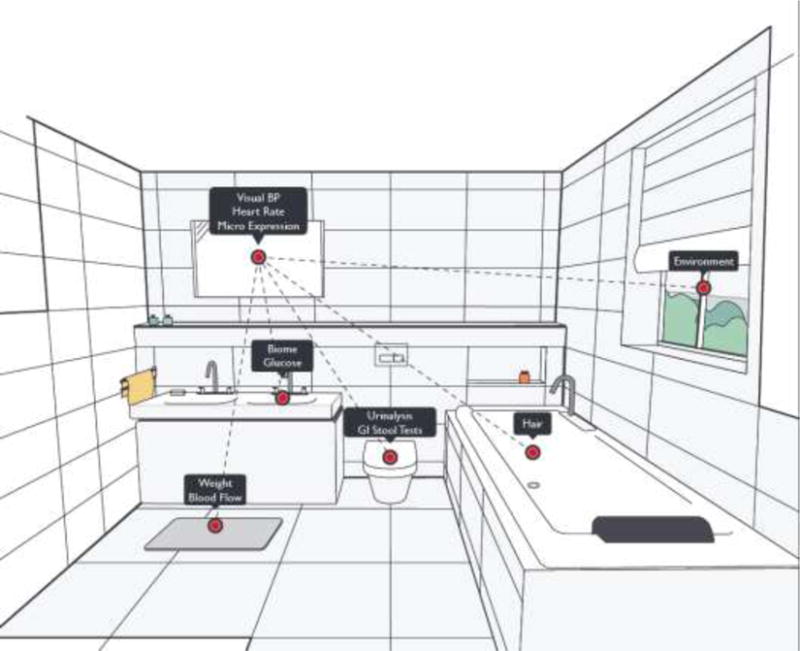Julia is nudged awake at 06:15h, her optimum waking time as determined by patterns of her vital signs and body movements, which are all measured by her mattress as she sleeps. Although prone to orthostatic hypotension, the floor- based hallway sensors do not detect any unsteadiness as she walks to the bathroom. Upon sitting on the toilet, a rapid assessment of her blood pressure, cardiac stroke volume, bodyweight, urine, and stool assays takes place. When she looks in the mirror, a reminder of her medications appears. Although Julia’s morning doesn’t yet look like this, it’s a glimpse into the future of smart medical homes.
Advances in smartphone and sensor technologies have digitized a range of medically relevant biometric data. Our living environments are also increasingly connected with an array of everyday appliances making up the “internet of things”. The collision of such technologies is poised to enable the medical smart home of the future, which might replace not only visits for health screening and chronic condition management, but also some of the need for hospital admission. With increasing emphasis in many countries of moving care delivery from the hospital to the home, the need for smart medical homes has never been greater. Innovation in smart medical homes also has the potential to provide post-discharge monitoring capabilities, observe that we are living healthily at home, detect disease patterns such as risk of falls and mood assessment, and provide a window for caregivers to diagnose and tailor treatments remotely.
Prevention of disease and health maintenance are key aspects of current research on smart medical homes. This research is pointing to what the smart homes of the future might be like. Floor mat pressure sensors, cameras, infrared, visual motion sensors, and pulse-Doppler radar have already been shown to be useful for fall detection and gait analysis in specially equipped senior living apartments. Integrated data streams from these sensors communicated in real-time with caregivers could improve safety oversight by providing alerts on the detection of an in-home emergency and a longitudinal evaluation of a person’s mobility trend. In addition, future medication adherence could be assessed by smart pill boxes, as well as radiofrequency-labelled medications, facial recognition, and swallowing monitored by smartphone video, TVs, or video-equipped mirrors in the home. Monitoring what we eat is another area that might be incorporated in future smart medical homes. Dietary patterns could be assessed using information from smart fridges and online food ordering requests; mobile device spectrometers are in development to capture and analyze food intake. By combining such dietary information with passively collected weights taken by scales in the floor of the bathroom or toilet seat, individualized eating plans could be recommended.
Body worn devices and point-of-care diagnostics that interface with these home-based sensors could also play a part in continuous health monitoring. Wrist-worn accelerometers could be useful in detecting position changes (seated to standing), falls, activity, and health status. Continuous vital sign monitoring, including heart rate and rhythm, blood pressure, respiratory rate, or blood oxygen concentration, could be passively monitored through wearable devices or sensors built into chairs and beds. In addition, a broad range of point-of-care diagnostics using breath, urine, saliva, or finger-stick blood have the potential to allow for diagnoses and the initiation of treatment of acute conditions remotely. When transfer to a hospital is required, the smart medical home could assist in providing automated notification to the emergency services, the exact location of the patient, and channels of communication with family and care providers.
Although huge potential exists for care delivery in the smart medical home, several obstacles remain such as usability, data privacy and security, integration and processing of diverse data streams, validation of clinical grade sensors, and the need for high quality evidence showing improved efficacy and cost-effectiveness. Many people may wish to have no part of such intensive monitoring with its Orwellian connotations, but for short-term surveillance for a medical condition the smart medical home may be preferable to hospital admission. The intersection of internet enabled home utility management and physiological and biomarker sensing provides a tantalizing glimpse into the potential of the smart medical home. Matching this growing capability with an increasing need for clinical care to be delivered in the home environment could transform where health care is provided in the years to come.
Figure.

Further reading
- 1.Claes V, Devriendt E, Tournoy J, Milisen K. Attitudes and perceptions of adults of 60 years and older towards in-home monitoring of the activities of daily living with contactless sensors: an explorative study. Int J Nurs Stud. 2015;52:134–48. doi: 10.1016/j.ijnurstu.2014.05.010. [DOI] [PubMed] [Google Scholar]
- 2.Lin CC, et al. Development of Home-Based Frailty Detection Device Using Wireless Sensor Networks. J Med Biol Eng. 2016;36:168–177. doi: 10.1007/s40846-016-0127-y. [DOI] [PMC free article] [PubMed] [Google Scholar]
- 3.Liu L, Stroulia E, Nikolaidis I, Miguel-Cruz A, Rios Rincon A. Smart homes and home health monitoring technologies for older adults: A systematic review. Int J Med Inform. 2016;91:44–59. doi: 10.1016/j.ijmedinf.2016.04.007. [DOI] [PubMed] [Google Scholar]
- 4.Marston HR. Handbook of Smart Homes, Health Care and Well-Being. Handb Smart Homes, Heal Care Well-Being. 2015:1–9. doi: 10.1007/978-3-319-01904-8. [DOI] [Google Scholar]
- 5.Peetoom KKB, Lexis MAS, Joore M, Dirksen CD, De Witte LP. Literature review on monitoring technologies and their outcomes in independently living elderly people. Disabil Rehabil Assist Technol. 2015;10:271–94. doi: 10.3109/17483107.2014.961179. [DOI] [PubMed] [Google Scholar]
- 6.Rantz MJ, et al. Sensor technology to support Aging in Place. J Am Med Dir Assoc. 2013;14:386–91. doi: 10.1016/j.jamda.2013.02.018. [DOI] [PMC free article] [PubMed] [Google Scholar]
- 7.Reeder B, et al. Framing the evidence for health smart homes and home-based consumer health technologies as a public health intervention for independent aging: a systematic review. Int J Med Inform. 2013;82:565–79. doi: 10.1016/j.ijmedinf.2013.03.007. [DOI] [PMC free article] [PubMed] [Google Scholar]


